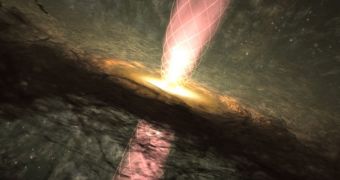A group of astronomers was recently able to determine that cosmic objects known as protostars – the precursors of fully-fledged stars – are capable of emitting strong cosmic jets.
This type of behavior had previously only been found to exist in black supermassive black holes and their smaller counterparts. But scientists say that newly-born stars are perfectly capable of using the same mechanisms to do this as well.
The object that was studied in the new investigation is called IRAS 18162-2048, and it lies some 5,500 light-years away from our planet. Researchers found evidence that the young stellar object emitted streams of charged particles from its poles.
These emissions were found to be traveling at nearly the speed of light, and they were permeated by powerful magnetic fields. This is precisely how jets are believed to form inside black holes.
One of the main implications for the new discovery is that the class of cosmic objects which includes stars, protostars and black holes of all sizes, rely on the same mechanisms to produce their emissions.
Astrophysicists now believe that a combination of shock waves and strong magnetic fields are used to focus and accelerate streams of charged particles emanating from these objects to nearly the speed of light, Space reports.
“Our discovery gives a strong hint that all three types of jets originate through a common process,” says expert Carlos Carrasco-Gonzalez, who is based at the National Autonomous University of Mexico.
He also holds an appointment with the Andalucia Spanish National Research Council (ASNRC) Astrophysical Institute. He and colleagues used the Very Large Array (VLA) radio telescope for this study.
Earlier researches of this body had proposed that it had a cosmic jet emanating from it, but thus far no thorough investigation had been conducted on the issue. The study confirmed the existence of a 17 light-year long jet from the protostar.
Astronomers used the VLA because it could detect electromagnetic fields that were oscillating in the same plane, which is a phenomenon called polarization. Jets from regular and supermassive black holes were confirmed to feature polarization.
“In the future, combining several types of observations could give us an overall picture of how magnetic fields affect the young star and all its surroundings,” explains scientist Luis Rodriguez.
“This would be a big advance in understanding the process of star formation,” he adds. The expert holds an appointment as an astronomer at the National Autonomous University of Mexico.
Details of the work appear in the November 26 issue of the journal Science.

 14 DAY TRIAL //
14 DAY TRIAL //